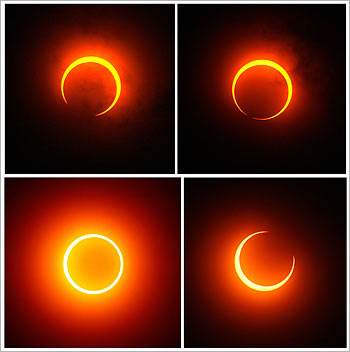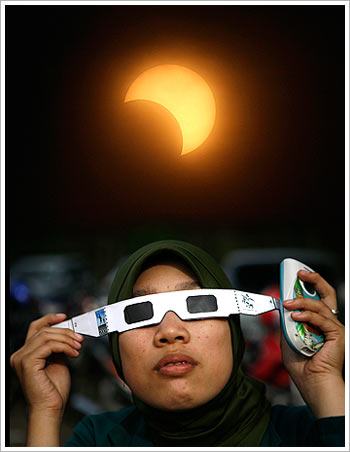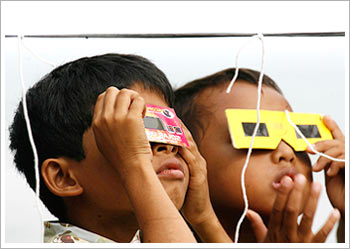Photographs: Beawiharta/Reuters
The longest solar eclipse of the millennium began around 11 am this morning and is expected to finish around 3:15 pm, with the maximum eclipse to be witnessed at 1:39 pm.
The people of Delhi, Tamil Nadu, Mumbai, Varanasi, Chennai, Kurkshetra and Kerala are witnessing the solar eclipse at present.
The photosphere of the sun will be covered by the moon and form a ring of fire in the sky for more than 10 minutes in some parts of India.
If you know the dos and don'ts, a solar eclipse can be an event to remember. Warnings will probably be posted all over the place of sighting, but, here's reinforcing a few musts:
Solar eclipse don'ts
Photographs: Pablo Sanchez and Beawiharta, both Reuters
- Don't look directly at the sun throughout the progress of the eclipse (during the partial eclipse). Looking directly at the sun can permanently damage your eyes. Therefore, as the sun is being eclipsed remember to wear solar filters or welders' goggles. These must be worn after the total eclipse too, as the sun begins to be visible once more.
- Don't use sunglasses to view the eclipse. Even the best of Polaroid's can't save your eyes from the sun's intense glare.
- Don't worry about the harm the solar eclipse will do to your baby, if you are pregnant. Research shows that an eclipse does not affect the baby inside the womb.
- Don't buy the filter or film from spurious, road-side vendors. There are scores of unsafe filters like color films, black-and-white films that contains no silver, smoked or colored glass, photographic neutral density filters and polarizing filters. Most of these transmit high levels of invisible infrared radiation which can cause a thermal retinal burn, which translates into damaging your eyes.
Solar eclipse dos
Photographs: Crack Palinggi/Reuters
- Get a headstart of at least 20-30 minutes before the actual eclipse if you are thinking of watching it from another location.
- You can look at the sun directly when it is completely eclipsed. It is safe to watch the sun when the moon completely blocks the intense light (not before or after).
- To view the progression of the eclipse, you may want to use a pinhole camera. You can make one yourself by using two thin, stiff pieces of cardboard. Make a clear hole with a pin in the centre of one cardboard piece. Place the second piece below the first, a little distance away. As the eclipse begins, stand with your back towards the sun (as mentioned earlier, never look at the sun directly during the progression) holding the two pieces in front of you, letting the sunlight fall on the first. The light will pass through the pinhole, casting an inverted image of the sun on the second piece below. You can increase or decrease the size and brightness of the image by moving the pieces closer or farther apart.
- Use binoculars or a telescope to view the total eclipse, if you have access to one. If you plan to use these during the progression, make sure they are fitted with solar filters.
- View the eclipse from a safe location. Avoid crowded temples or public viewing spots, unless it is managed by professionals like Nehru Planetarium or meteorologists.
- Eat at timely intervals through the day. Especially, if you are traveling to a remote location. Fasting may prevent you from enjoying the moment.
- View the eclipse from a place that is not cluttered, like the terrace of a high-rise building, or a remote field without any trees, or even a place outside the city. Wherever your view is not likely to get blocked by buildings, trees, etc.
- Remember to pack your bag the night before if you are a photography buff and you want to capture the eclipse. Of course, do remember the event is bigger than the photograph.




Comment
article